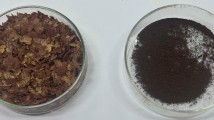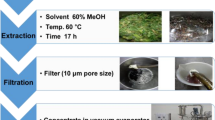Abstract
This study was aimed to analyze chemical components of essential oil from whole fruits of Citrus unshiu and its fragrance and to investigate its bio-functions as a skin-health finishing agent to textiles. The components of oil and fragrance were respectively determined by using both FT-IR and GC-MS. As for bioactive properties, the skin irritancy from oil was assessed by Kawai’s method and antimicrobial activity was evaluated by MIC (minimum inhibitory concentration). As results, major component of the citrus oil was identified as D1-limonene which also constituted most of its fragrance. Any skin reaction was not found by Kawai’s method, which means that the citrus oil does not cause irritancy on human skin. As for microbial activity against S. aureus, K. pneumoniae, and P. acnes, the lowest minimum inhibitory concentrations were 0.50 mg/ml, 0.28 mg/ml, and 0.23 mg/ml, respectively. These results suggest that Citrus unshiu’s essential oil could be utilized as a bioactive natural finishing agent for skin-healthcare textiles.
Similar content being viewed by others

References
T. Kim and Y. Son, Dyes Pigments, 64, 85 (2005).
E. Yi and E. Yoo, Text. Res. J., 80, 2117 (2010).
S. R. Sridhar, R. V. Rajagopal, R. Rajavel, S. Masilamani, and S. Narasimhan, J. Agric. Food Chem., 51, 7596 (2003).
K. Adam, A. Sivropoulou, S. Kokkini, T. Lanaras, and M. Arsenakis, J. Agric. Food Chem., 46, 1739 (1998).
K. A. Hammer, C. F. Carson, and T. V. Riley, J. Appl. Microbiology, 86, 985 (1999).
M. Gu-Llu-Ce, M. So-Kmen, D. Daferera, G. Agÿar, H. OZkan, N. Kartal, M. Polissiou, A. So-Kmen, and F. Sü Ahiún, J. Appl. Microbiology, 51, 3958 (2003).
K. Fisher and C. A. Phillips, J. Appl. Microbiol.,, 101, 1232 (2006).
S. Kim, J. S. Baik, T. Oh, W. Yoon, N. H. Lee, and C. Hyun, Biosci. Biotechnol. Biochem. 72, 2507 (2008).
M. Lota, D. R. Serra, F. Tomi, and J. Casanova, Biochem, Systematics & Ecology, 29, 77 (2001).
J. S. Baik, S. Kim, J. Lee, T. Oh, J. Kim, N. H. Lee, and C. Hyun, J. Microbiol. Biotechnol., 18, 74 (2008).
H. S. Choi and M. Sawamura, Biosci. Biotechnol. Biochem., 66, 439 (2008).
M. Sawamura, N. Thi Minh Tu, Y. Onishi, E. Ogawa, and H. S. Choi, Biosci. Biotechnol. Biochem., 68, 1690 (2004).
H. S. Choi, J. Agric. Food Chem., 51, 2687 (2003).
S. Simard, J. M. Hachey, and G. J. Collin, J. Wood Chem. Technol., 8, 561 (1988).
M. Sanguinetti, B. Posteraro, L. Romano, F. Battaglia, T. Lopizzo, E. De Carolis, and G. Fadda, J. Antimicrob. Chemother., 59, 305 (2007).
A. R. Lee, J. Hong, Y. A. Yang, and E. Yi, Fiber. Polym., 11, 982 (2010).
T. Fujita, T. Shiura, M. Masuda, M. Tokunaga, A. Kawase, M. Iwaki, T. Gato, M. Fumuro, K. Sasaki, N. Utsunomiya, and H. Matsuda, J. Nat. Med., 62, 202 (2008).
S. P. Chawla, C. Jo, H. J. Kang, M. J. Kim, and M. W. Byun, J. Food Sci. Nutr., 8, 301 (2003).
C. Jo, B. J. Park, S. H. Chung, C. B. Kim, B. S. Cha, and M. W. Byun, Food Sci. Biotech., 13, 384 (2004).
Y. Kim, “Extraction, Analysis, and Antimicrobial Activity of Essential Oil from the Peel of Satsuma Mandarine, Citrus unshiu Marc.”, MS Thesis, Jeju National University, Korea, 1999.
H. J. Oh, H. M. Ahn, S. S. Kim, P. Y. Yun, G. L. Jeon, Y. H. Ko, and K. Z. Riu, J. Appl. Biol. Chem., 50, 148 (2007).
H. Choi and M. Sawamura, J. Food Sci. Nutr., 7, 5 (2002).
K. P. Farrell and E. Israel, Am. J. Epidemiol., 125, 509 (1987).
L. Dubertret, D. Serraf-Tircazes, M. Jeanmougin, P. Morlière, D. Averbeck, and A. R. Young, J. Photochem. Photobio. B: Biology, 7, 251 (1990).
A.-T. Karlberg, A. Boman, and B. Melin, Ann. Occup. Hyg., 35, 419 (1991).
M. Matura, A. Goossens, O. Bordalo, B. Garcia-Bravo, K. Magnusson, K. Wrangsjo, and A. Karlberg, J. Am. Acad. Dermatol., 47, 709 (2002).
K. Kawai, “Kawai Method for Testing Irritation, in “Marzulli and Maibach’s Dermatotoxicology” (F. Marzulli, H. Zhai, H. I. Maibach, and K. Wilhelm Eds.), 7th ed., Chapter 45, p.391, CRC Press, New York, 2007.
K. Kawai, J. Japan Res. Assoc. Text. End Uses, 36, 6 (1995).
H. S. Choi and K. C. Min, Food Sci. Biotech., 13, 126 (2004).
M. E. I. Badawy, J. Appl. Polym. Sci., 117, 960 (2010).
Author information
Authors and Affiliations
Corresponding author
Rights and permissions
About this article
Cite this article
Lee, A.R., Yi, E. Bioactive properties of Citrus unshiu’s essential oil for its application to textiles. Fibers Polym 14, 1295–1300 (2013). https://doi.org/10.1007/s12221-013-1295-9
Received:
Revised:
Accepted:
Published:
Issue Date:
DOI: https://doi.org/10.1007/s12221-013-1295-9



